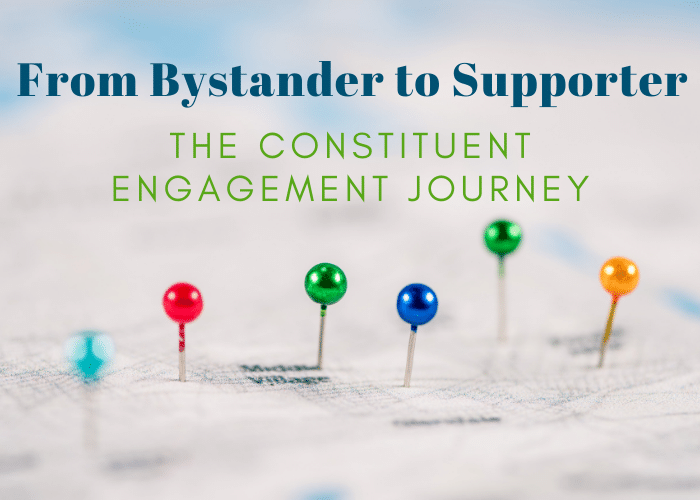
From Bystander to Supporter, the Constituent Engagement Journey
Think about the people who really love your organization. The ones who read everything you send to them, tell others about your work, show up at all your events, give whatever time or money they can. The ones who go above and beyond – who do things for your organization that you hadn’t even thought to ask anyone to do and are your biggest fans.
Those are your most engaged constituents.
Don’t you wish you could clone them? You can’t, but you can take specific, concrete steps to make your organization truly constituent-centered and draw more of those amazing people to you.
Definitions
Constituents: People who are integral to your success; they are necessary for you to meet your strategic goals; a constituent element—part of the whole. They are the participants, volunteers, donors, supporters, friends, ambassadors—that you want to act on your behalf. Engagement moves people from bystanders or uninvolved observers to loyal, engaged supporters and advocates.
Constituent-centered: Aligning all aspects of an organization around an understanding of the core constituents to create loyal, engaged, long-term relationships.
It Takes More Than Marketing
First, let’s distinguish between marketing and being constituent centered.
| Marketing | Constituent-Centeredness |
| A systematic, data-driven process that relies on learning about what your audience wants and needs from you | An organization-wide mindset that is integrated into the culture and affects how everyone goes about their work |
| Uses a tool like a marketing action plan to identify and understand your audiences, develop strategies to reach them, and connect | Relies on a deep understanding of your constituents and aligns your operation based on that – everyone plays a role |
While both are based on understanding constituent needs and interests, constituent-centeredness is more than an organizational function. It is something imbued into an organization’s culture -– woven into every fiber of what it does and how it works. Think mindset, values, attitudes, and norms rather than product, placement, price, and promotion.
Getting Started: Constituent Engagement Journey Exercise
Businesses often use a tool called the customer journey to map out how a person goes from first learning about the product to making a purchase. It helps a business put themselves in their customer’s shoes and see the experience from a new angle. This helps them identify places during the journey when they can improve and move their customer along (touch points).
This constituent engagement journey exercise adapts this tool to a mission-based context, where the goal is to become more constituent-centered and increase engagement rather than sales.
Who: Being constituent-centered is everyone’s job – not those who work in outreach, fundraising, or membership. Involve everyone in your organization who interacts with current and potential constituents: staff, board, volunteers
First: Select a journey to map, for example
- From first learning about the organization to becoming an active volunteer
- From calling to ask about your services to actively participating in your program
- From walking in your front door to walking out following a meeting or event
Next: Identify the touch points along the journey’s path. Keep in mind that this is from your constituent’s point of view. What do they see, hear, notice? Who interacts with them? What happens next?
Then: Examine the touch points one-by-one. Each is an opportunity to create a ‘wow’ experience and move them along in their journey. Have the group consider:
- What is a successful, even an extraordinary, engagement at each touch point?
- In what ways is the touch point set up to foster that deeper engagement?
- What are the obstacles to engagement along that path?
- What other opportunities do you see for touch points?

Facilitation Tips
- Make it visual – draw the journey and touch points on a whiteboard (in-person or online)
- Remind the group to focus on the constituent’s needs and interests, not the organization’s (How does what we know about our constituents tell us about how to improve this touch point?)
- Wrap up by identifying the specific changes or improvements you want to make and assigning responsibility and a deadline to related tasks
Share the Idea of Constituent-Centeredness with Your Team
For a free webinar on building a constituent centered organization, or for more information on how to create a simple marketing action plan call or email Shelli@nonprofitimpact.com 303-223-4886 x 1.

